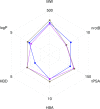Online structure-based screening of purchasable approved drugs and natural compounds: retrospective examples of drug repositioning on cancer targets
- PMID: 30190791
- PMCID: PMC6122352
- DOI: 10.18632/oncotarget.25966
Online structure-based screening of purchasable approved drugs and natural compounds: retrospective examples of drug repositioning on cancer targets
Abstract
Drug discovery is a long and difficult process that benefits from the integration of virtual screening methods in experimental screening campaigns such as to generate testable hypotheses, accelerate and/or reduce the cost of drug development. Current drug attrition rate is still a major issue in all therapeutic areas and especially in the field of cancer. Drug repositioning as well as the screening of natural compounds constitute promising approaches to accelerate and improve the success rate of drug discovery. We developed three compounds libraries of purchasable compounds: Drugs-lib, FOOD-lib and NP-lib that contain approved drugs, food constituents and natural products, respectively, that are optimized for structure-based virtual screening studies. The three compounds libraries are implemented in the MTiOpenScreen web server that allows users to perform structure-based virtual screening computations on their selected protein targets. The server outputs a list of 1,500 molecules with predicted binding scores that can then be processed further by the users and purchased for experimental validation. To illustrate the potential of our service for drug repositioning endeavours, we selected five recently published drugs that have been repositioned in vitro and/or in vivo on cancer targets. For each drug, we used the MTiOpenScreen service to screen the Drugs-lib collection against the corresponding anti-cancer target and we show that our protocol is able to rank these drugs within the top ranked compounds. This web server should assist the discovery of promising molecules that could benefit patients, with faster development times, and reduced costs and risk.
Keywords: cancer; docking; purchasable approved drugs; repositioning; virtual screening.
Conflict of interest statement
CONFLICTS OF INTEREST The authors declare no conflicts of interest.
Figures





References
-
- Stahura FL, Bajorath J. Virtual screening methods that complement HTS. Comb Chem High Throughput Screen. 2004;7:259–69. - PubMed
-
- Ripphausen P, Nisius B, Peltason L, Bajorath J. Quo vadis, virtual screening? A comprehensive survey of prospective applications. J Med Chem. 2010;53:8461–7. - PubMed
-
- Tanrikulu Y, Kruger B, Proschak E. The holistic integration of virtual screening in drug discovery. Drug Discov Today. 2013;18:358–64. - PubMed
-
- Smietana K, Siatkowski M, Moller M. Trends in clinical success rates. Nat Rev Drug Discov. 2016;15:379–80. - PubMed
LinkOut - more resources
Full Text Sources
Other Literature Sources
Miscellaneous

